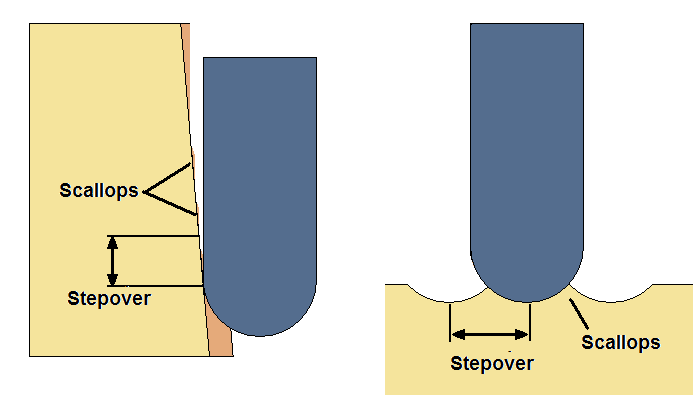Tips on surface milling with ballnose endmills.
November 18, 2013, 1:13 amArticle Summary
Eldar Gerfanov (Admin)
November 18, 2013, 1:13 am
Eldar Gerfanov (Admin)
February 13, 2025, 12:25 am
15152
Public
Author Summary
Mon December 29, 2025, 9:23 am
Mon December 29, 2025, 9:23 am
Surface milling has always been a blend of intuition and experience for me. Here are my insights on best practices, tips, and tricks.
Step-Over Considerations
In general, you want to create a continuous toolpath that minimizes direction changes. Frequent changes slow the machine down, reduce the feed rate, alter cutter deflection, and can cause gouge marks on the surface.
When working with long, narrow pieces, it is more efficient to mill along the longest side. This approach saves time, reduces machine wear, and minimizes direction changes.
Additionally, circular lead-ins on step-over movements can improve results.
Finish Allowances
Surface milling typically involves roughing, semi-finishing, and finishing steps.
-
Leave 0.015 inches after roughing.
-
Leave 0.003 inches after semi-finishing.
-
Finish to zero, using progressively smaller tools.
A 0.005-inch step-over generally provides a good finish when using ball mills.
Common chip loads for surface finishing:
-
0.003–0.005 inches per tooth.
Shallow Surfacing Considerations
Ball mills perform poorly in shallow areas because the center of the tool does not cut efficiently—it drags rather than cuts.
Proper Step-Down and Milling Direction
The straight portion of the flute acts as a wiper, reducing the scallop left by the ball portion. This is why milling from top to bottom is safer and results in a better surface finish.
The closer the wall taper angle matches the flute taper, the better the finish will be.
Another reason to mill from top to bottom is tool stability. Engaging stock near the tip of the tool provides a more stable cut and reduces the risk of burying the tool unexpectedly.

Climb Milling vs. Conventional Milling
Avoid switching between climb and conventional milling unless absolutely necessary to save rapid travel time.
Switching between the two causes uneven tool deflection:
-
Climb milling deflects the tool away from the workpiece.
-
Conventional milling deflects the tool into the workpiece, creating visible "zebra" marks on the surface.
Setting Up in a Speed and Feed Calculator
To determine the best speeds and feeds for surface milling with ball nose end mills using HSMAdvisor, follow these steps:
-
Enter the exact tool geometry.
-
This is crucial because ball nose tools often have long stick-out and complex geometries.
-
-
Enter the expected engagement parameters:
- Consider the type of the operation. Is it a finishing or roughing pass?
-
If milling a pocket, enable the Slot/Pocket option and set the depth of cut (DOC) to the step-down value.
-
Enable HSM and Chip Thinning. Ball nose end mills generally assume some level of chip thinning at all times, so enabling these options is beneficial.
-
If performing side milling, set the width of cut (WOC) to the material removed from the wall and set the DOC to the tool radius.
- Adjusting for Best Results
-
-
If it is a finishing operation, consider adjusting the feed rate so that the chip load matches the step-down value.
This ensures uniform surface roughness in all directions. For finishing, this usually means reducing the feed rate.
-
Example Setup for a Tapered Ball End Mill
Tool: 1/8" 2-flute carbide ball end mill with a tapered shoulder and 1/4" shank.
Operation: Waterfall (Z-level) surface-finishing milling, removing approximately 0.005 inches from the side wall with a 0.005-inch step-down.
-
DOC is set to 0.065 inches, assuming this is the maximum engagement.
The goal is not to maximize material removal rate but to achieve a good finish. A chip load approximately equal to the vertical step-over is a good starting point.
_image.png)
Cheers!